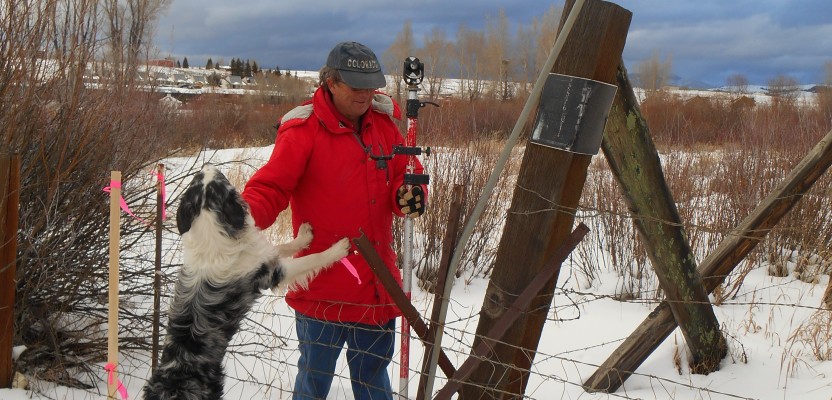Igor Kidinsky thought about another career for a fleeting moment.
His cold fingers struggled to fine-tune the total station. As an Afghanistan war veteran, he sometimes dreamt of spending his life closer to a beach rather than continue freezing in the mountains. He would leave his crew-name of Eager (the Kid) behind and put his skilled, warm fingers to use elsewhere, at sea level.
“Nah,” he laughed at himself. “Duty calls me here.”
Just then Glenny Dale, known as Glutton (The Old Man), shouted loudly and clearly—just as he learned as a WWII Marine—“Old one-inch pin at fence corner!”
Both had radios, but the Old Man rarely used them. Instead he shouted all his instructions to his instrument man, Eager (the Kid). On this 20 degree cloudy day, an old man could shout his instructions clearly through the crisp, still air.
The crew shot in the old pin, then two more pins lying about one foot apart, both about five feet north of the old pin.
They were done collecting the evidence. The Kid pushed out thoughts of frozen fingers and began formulating his own logical retracement strategy, hoping to understand what the Old Man would certify.
The Kid reasoned to himself, “We know that this section line was first established in 1878. In the early 1900s, these ranches were homesteaded. Surveyors then laid out ranches and metes and bounds tracts from section corners and ¼ corner monuments that are still in place.
“A state highway came through here, first as a two-lane, and then widened into a four-lane in 1971, well platted and monumented.
“In 1973, the BLM did a dependent resurvey and found original stones that differed significantly east-west from the location of section corners the local surveyors had been using for at least 60 years.”
Now he pondered the multiple monument maze. “The old pin was obviously set from the wrong section corner! In 1980, local surveyor A set his pin precisely at the intersection of the 1973 section line with the monumented east right of way of this highway, for a metes and bounds retracement.
“In 2002, local surveyor B rejected both monuments and set a third pin precisely at the intersection of the true section line and a point for the east right of way lying exactly the platted distance of 200.00 feet from the west right of way monument. This pin is for a recorded subdivision, lying 0.8 foot east of monument B.
“Therefore,” the Kid concluded out loud as the Old Man arrived, “I would accept multiple monument B because the highway must have no less than 200.00 feet and it’s a recorded subdivision corner!”
The Old Man had also been piecing the facts together and spoke after catching his breath. “What you are looking at is the result of American surveyors: a working society. These other pins A and B are an example of later surveyors breaching that peace, over the question of precision.”
Try to imagine the United States without surveyors.
At the Texas Panhandle you will find an area along the Canadian River that was surveyed in three different projects: 1838, 1845, and 1849. Lt. James W. Abert was a West Point captain of the U.S. Topographic Engineers. He explored and mapped the area for farming, ranching, and minerals, risking retribution from the fierce Comanche long before any sane settler. Other surveyors sought and mapped the area looking for railroad routes, long before a single tie could be laid or dollar invested. He led parties to search for suitable settlements or intriguing industry.
Abert joined Fremont on one of his survey expeditions, fought in the Mexican-American War, was wounded at Antietam, and later taught English, math, and drawing. His work led the way to settlements, ranching, the tapping of the largest gas reserve in the world, oil production, and railroads around the panhandle.
The Old Man made his decision. “You can see that both ranches have been grazing the property up to this fenceline. As far as the right of way goes, remember that holding a perfect, platted 200.00’ right of way pertains only to the last resort of proportion, which we are not doing!
“The landowners have established certain legal rights to this fenceline, and that is what I am required to retrace. Monuments A and B are precise stake-out points. This old pin is the property corner.”
“But, Texas is not a PLSS state, and we’re not doing a topo or geological survey. How do you draw any connection between a US topographic surveyor and this PLSS survey?” the Kid asked.
“Without the Civil War, we wouldn’t have these United States and a Homestead Act of 1862,” the crotchety crewchief continued. “This land also flew the Spanish and French flags at one time, and the Mexican-American War affected boundaries for Texas and five PLSS states.
“We live in a state that has a Fremont County and a Fremont Peak, and we can see in plain view a settlement, farmland, ranches, river, industry, and railroads. This very railroad at one time shipped cattle, brought by cowboys from northwest Texas.
“And, Texas has multiple monuments, which shows that the framework for our society, and how surveyors work, is not much different at all between the states.”
Both surveyors were silent while walking to the truck. “Thanks for fighting to protect all of this, Corporal Kidinsky,” the Old Man said seriously to the not-so-young Kid.
“Thank you for fighting to protect all of this, Private Dale,” Eager said to the very Old Man, while starting the truck, cranking up the heater, and turning the radios off.

